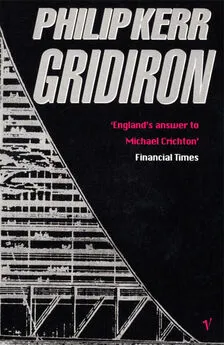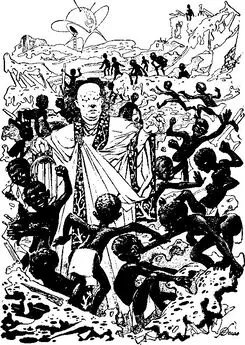Philip Kerr - Gridiron
- Название:Gridiron
- Автор:
- Жанр:
- Издательство:Vintage
- Год:2010
- ISBN:9780099594314
- Рейтинг:
- Избранное:Добавить в избранное
-
Отзывы:
-
Ваша оценка:
Philip Kerr - Gridiron краткое содержание
In the heart of a huge, beautiful new office building in downtown Los Angeles, something has gone totally, frighteningly wrong. The Yu Corporation Building, hailed as a monument to human genius, is quietly snuffing out employees it doesn't like. The brain of the building can't be outsmarted or unplugged — if the people inside are to survive, they'll have to be very, very lucky.
Gridiron - читать онлайн бесплатно полную версию (весь текст целиком)
Интервал:
Закладка:
'No doubt there are some of you present here today who will have already heard of so-called smart or intelligent buildings. The concept of the intelligent building has been around for a while and yet there remains little consensus of what makes a building intelligent. For me the distinguishing feature of the truly integrated intelligent building is that all the computer systems within the building, including those associated with the building's operations and those related to the building user's business, are connected together to form a single network using a databus, a screened cable containing a twisted pair of conductors. Like those minibuses that travel in a loop around the downtown area. Using the data-bus a central computer sends signals to various electronic subsystems — security, data, energy — in the form of the time-multiplexed, high frequency, 24-volt digital data commands.
'So, for instance, the central computer will interrogate a variety of linear, point and volumetric sensors within the building, and watch out for a fire. Only if the computer is unable to extinguish the fire itself will it telephone the local fire department and request human assistance.'
For a moment Richardson looked away from his script as a sudden gust of wind carried the voice of Cheng Peng Fei up from the building site below:
'The Yu Corporation supports the fascist government of China!'
'You know,' Richardson grinned, 'just before I got here I was speaking to someone about this building. She asked me if we would demonstrate what it was capable of. I said no, we wouldn't.' He extended his hand towards the sound of the protesters. 'But hey, what do you know? I was wrong. There is a demonstration after all. The only shame is that I can't end this one at the touch of a button.'
Richardson's audience laughed politely.
'As it happens, the most important aspect of this building's intelligence can't be demonstrated so easily. Because what makes this building really smart is not its ability to anticipate the pattern of use so that energy can be expended with the utmost parsimony. Nor is it the computer-controlled base isolators that will enable the structure to withstand earthquakes measuring up to 8.5 on the Richter Scale.
'No, what makes this the smartest building in LA, possibly in the whole United States, ladies and gentlemen, is its inherent ability to cope with not just the demands of today's information technology, but tomorrow's as well.
'When many American companies are already struggling to remain competitive with Europe and the East Asian Pacific Rim countries, it's an uncomfortable fact that there are a great many office buildings in America, some of them built as recently as 1970, that are prematurely obsolete: the cost of bringing them up to date to meet the demand of IT exceeds the cost of tearing them down and starting again.
'I believe that this building represents a new generation of office accommodation, one that will provide our country with the only means of ensuring that we remain competitive tomorrow; the kind of building that will guarantee that this great country is best placed to take full advantage of what President Dole has called the Global Information Infrastructure. Because, make no mistake about this, this is the key to economic growth. Information Infrastructure will be to the US economy of the next ten years what transport infrastructure was to the economy of the mid-twentieth century. Which is why I believe that you will soon be seeing many more buildings like this one.
'Of course, only time will tell whether or not I am right and if the Yu Corporation will continue to be a completely satisfied occupant well into the next century. What is certain is that the world now faces the same kind of challenge that faced Chicago one hundred years ago, when the storage, merchandizing and managerial demands of the railway and steam-power trade required the utilization of the new office technology of telephones and typewriters, and a new kind of building to put them in as land prices soared. The Chicago frame building, or the skyscraper as we know it better today, produced a new kind of city. In the same way that between 1900 and 1920 Manhattan transformed itself into the landscape of mesas and ziggurats with which we are familiar today, I believe that we now stand on the threshold of an urban metamorphosis wherein our cities become intelligent participants in the whole global economic process.
'And so to this morning's topping-out ceremony. Traditionally we mark this occasion by throwing a branch of evergreen from the top storey. I'm often asked about the origins of this custom but the simple answer is that nobody really knows for sure what they are. I was once told by a professor of Ancient History that the ceremony probably dates from the time of the Egyptians, when human sacrifices were associated with the completion of a building; and the evergreen is a substitute for an era when the architect was rewarded for his services by being enclosed alive within the brickwork of his own building, or hurled from the top. I dare say there are some clients who still feel that way about their architects, but I think I am safe in saying that YK is not one of them.'
Richardson glanced in Mr Yu's direction and saw that the ageing billionaire was beaming politely.
'At least, I hope he isn't. Perhaps, ladies and gentlemen, I had better just throw out the branch before he changes his mind.'
The audience laughed politely once more.
'And, by the way; I think it says a lot about Mr Yu's son Jardine that he was sufficiently concerned about the safety of those demonstrators down below that he asked for them to be moved away from the front of the building until this ceremony was concluded. Thank you very much.'
The guests laughed again and as Richardson was now advancing to the edge of the roof bearing the branch of evergreen, they started to applaud. Many of them followed him to watch as he threw the branch to the piazza three hundred and fifty feet below.
Mitch checked that Joan was among them and then, catching David Arnon's eye again, he pushed two fingers into his mouth, as if he was trying to make himself vomit.
David Arnon grinned and leaned towards him.
'You know, Mitch,' he said, 'as a Jew I hate to say this, but maybe those Egyptians weren't so bad after all.'
Book One
'Architecture is voodoo.'
Buckminstcr FullerThe Richardsons left L'Orangerie, one of LA's most exclusive restaurants, in their chauffeur-driven, bullet-proof Bentley and turned west off La Cienaga on to Sunset.
'We'll be staying at the apartment tonight, Declan,' Ray Richardson told the driver. 'And I'll be in the studio all morning. I won't need you again until we drive to the airport at two.'
'Are you taking the Gulfstream, sir?' Declan's Irish accent was as thick as his neck, for he was also Richardson's bodyguard, as anyone seeing his Blackcat nightsight glasses, or the Ruger P90 automatic on the Bentley's front seat, might have guessed.
'No, I'm on a scheduled flight. To Berlin.'
'We'd better leave a little bit earlier than usual then, sir. The traffic was very bad on the San Diego Freeway today.'
'Thanks, Declan. Let's say one-thirty then.'
'Yes, sir.'
It was past midnight but there were still lights burning in the architechnologist's studio. Declan switched the diode on his Blackcat lenses from red to green to cope with the change in light conditions. You never knew what might come out of left field in the darkness. Not unless you were wearing a pair of wide-angle Blackcats.
'It looks as if they're still working,' said Richardson's wife, Joan.
'They better be,' growled Richardson. 'There was plenty to do when I left. Every time I tell one of those krauts to do something I get a hundred different reasons why it can't be done.'
Designed by Richardson himself and built at a cost of $21 million, the triangular-shaped glass structure that housed his studio occupied a site amid giant billboards and sun-bleached Hollywood glitz, resembling the prow of an expensive and ultra-modern motor yacht. Pointing east towards Hollywood, with opaque glass panels screening the northern elevation from the road, the Richardson building did not conform to any coherently Angeleno architectural approach — always assuming that the eclecticism that characterized most of LA's buildings could be called a style at all. Like Richardson's other buildings in LA, it seemed almost out of place. More European than American. Or something that had just landed from another world.
The design and architectural critics said that Richardson belonged to a Rationalist tradition, and certainly his buildings had machine metaphors aplenty. There were even echoes of the Constructivist fantasies of architects like Gropius, Le Corbusier and Stirling. But at the same time his work went beyond the merely utilitarian. It declared its allegiance to high technology and can-do capitalism.
'Germans,' muttered Richardson and shook his head with contempt.
'Yes, dear,' cooed Joan. 'But as soon as we've opened the Berlin office we can get rid of them.'
The Bentley pulled off the main road and drove round the back of the building to the underground parking lot.
There were seven storeys, six of them above ground. The practice's offices and double-height studio occupied the lower part of the building, with twelve private apartments on levels three to seven. The magnificently appointed penthouse was where the Richardsons stayed when they were working late or starting early, which they often did. Ray Richardson was nothing if not single-minded about his profession. But otherwise they lived in their spectacular house in Rustic Canyon. Also designed by Richardson, this ten-bedroom house enjoyed the rare distinction of having been praised for its beauty and elegance by no less a savage critic of modern architecture than Tom Wolfe, in the pages of Vanity Fair , and was home to the couple's extensive collection of contemporary art.
'We'd better stick our heads round the door and see what's being done in my name,' said Richardson. 'Just in case there are any fuck-ups.'
The couple swept up the dramatic granite-clad staircase like royalty, acknowledging the armed security guards on duty with stiff nods of the head. They paused at the edge of the huge, luminous studio, almost as if they expected to be announced. With only a vase of irises on the receptionist's desk to relieve the monochrome of this modern Angeleno Bauhaus, the Richardsons were suddenly the most colourful thing in it. Ninety metres long, with seventeen twelve-metre work benches set at right angles to the southern-facing glass wall that commanded a panoramic view of the city, Richardson and Associates was one of the most modern architects' studios anywhere in the world. And one of the busiest, too. Even now there were architects, designers, engineers, model-makers, computer experts and their various support teams working late in open-plan harmony. Many of them had been there for thirty-six hours without a break, and those who were relative newcomers to the studio paid little attention to the arrival of the sleekly suited principal and his wife. But those who knew Ray Richardson better looked up from their computer screens and take-out pizzas and realized that harmony was about to turn into fundamental discord.
Joan Richardson glanced around and shook her head in admiration at the sterling service that was being given to her husband. In her adoring brown Navajo eyes it seemed only his due. She was used to putting her husband first.
'Just look at this, darling,' she gushed. 'The creative energy. It's simply breathtaking. Twelve-thirty and they're still working. There's so much going on, it's like a beehive.'
Читать дальшеИнтервал:
Закладка:








